Financial Control and Budgeting: Analysis of Health and Social Care
VerifiedAdded on 2023/06/14
|17
|5187
|66
Report
AI Summary
This report provides a comprehensive analysis of financial control and budgeting within the health and social care sector. It critically examines the legal, financial, and regulatory environment, evaluating alternative funding options like private finance institutions and agency partnerships. The report elaborates on agency theory in the context of the NHS and discusses effective communication strategies with stakeholders regarding budgeting. It also addresses the impact of financial constraints, costs, and budgets on health and social service managers, highlighting the challenges of budgeting in public sector organizations. Furthermore, the report explains the advantages and disadvantages of incremental and zero-based budgeting methods. Finally, it includes a calculation of the break-even point and margin of safety for the years 2018 and 2019, along with a critical discussion of the key assumptions related to the break-even model. This detailed analysis offers valuable insights into the financial management of health and social care services.

Financial control and
budgeting.
budgeting.
Paraphrase This Document
Need a fresh take? Get an instant paraphrase of this document with our AI Paraphraser
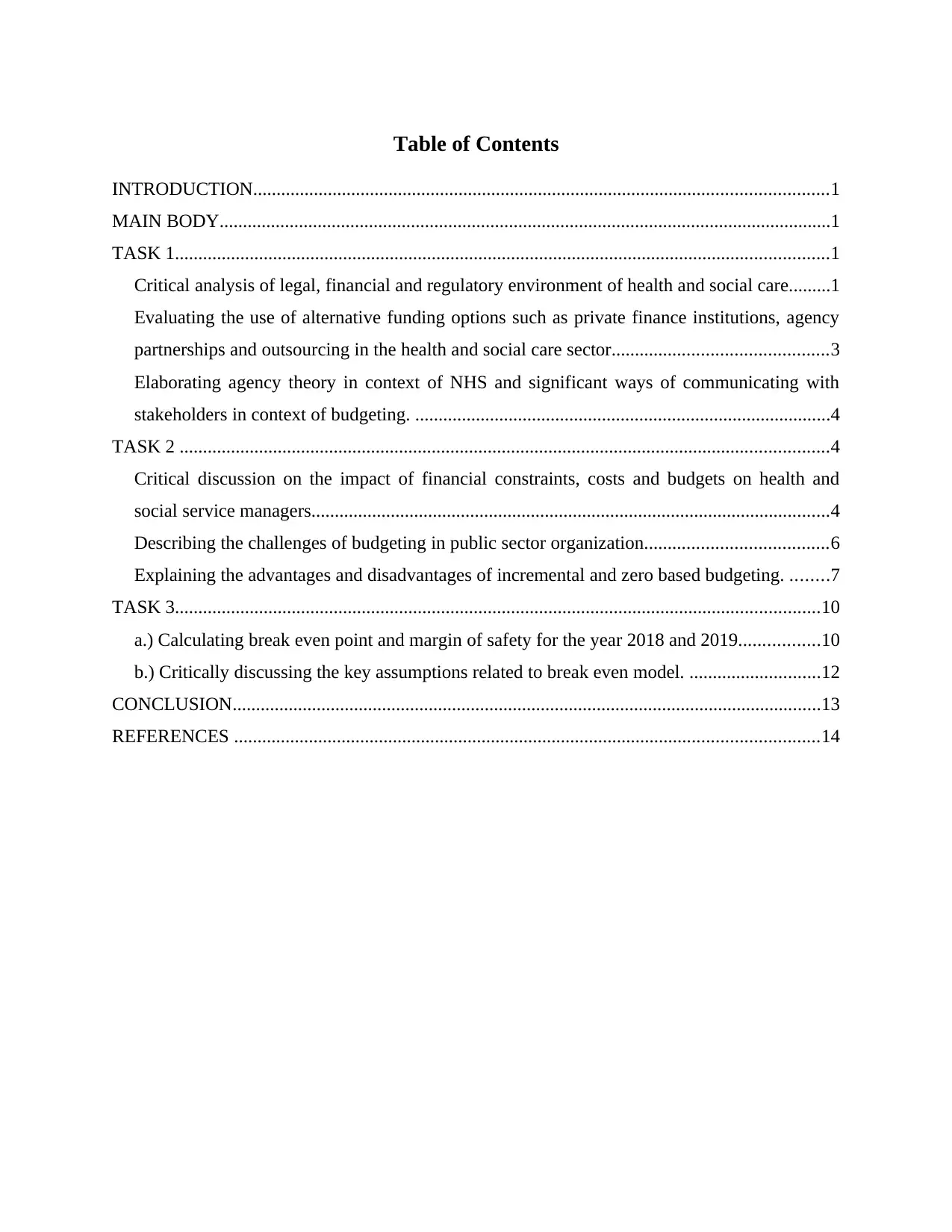
Table of Contents
INTRODUCTION...........................................................................................................................1
MAIN BODY...................................................................................................................................1
TASK 1............................................................................................................................................1
Critical analysis of legal, financial and regulatory environment of health and social care.........1
Evaluating the use of alternative funding options such as private finance institutions, agency
partnerships and outsourcing in the health and social care sector..............................................3
Elaborating agency theory in context of NHS and significant ways of communicating with
stakeholders in context of budgeting. .........................................................................................4
TASK 2 ...........................................................................................................................................4
Critical discussion on the impact of financial constraints, costs and budgets on health and
social service managers...............................................................................................................4
Describing the challenges of budgeting in public sector organization.......................................6
Explaining the advantages and disadvantages of incremental and zero based budgeting. ........7
TASK 3..........................................................................................................................................10
a.) Calculating break even point and margin of safety for the year 2018 and 2019.................10
b.) Critically discussing the key assumptions related to break even model. ............................12
CONCLUSION..............................................................................................................................13
REFERENCES .............................................................................................................................14
INTRODUCTION...........................................................................................................................1
MAIN BODY...................................................................................................................................1
TASK 1............................................................................................................................................1
Critical analysis of legal, financial and regulatory environment of health and social care.........1
Evaluating the use of alternative funding options such as private finance institutions, agency
partnerships and outsourcing in the health and social care sector..............................................3
Elaborating agency theory in context of NHS and significant ways of communicating with
stakeholders in context of budgeting. .........................................................................................4
TASK 2 ...........................................................................................................................................4
Critical discussion on the impact of financial constraints, costs and budgets on health and
social service managers...............................................................................................................4
Describing the challenges of budgeting in public sector organization.......................................6
Explaining the advantages and disadvantages of incremental and zero based budgeting. ........7
TASK 3..........................................................................................................................................10
a.) Calculating break even point and margin of safety for the year 2018 and 2019.................10
b.) Critically discussing the key assumptions related to break even model. ............................12
CONCLUSION..............................................................................................................................13
REFERENCES .............................................................................................................................14
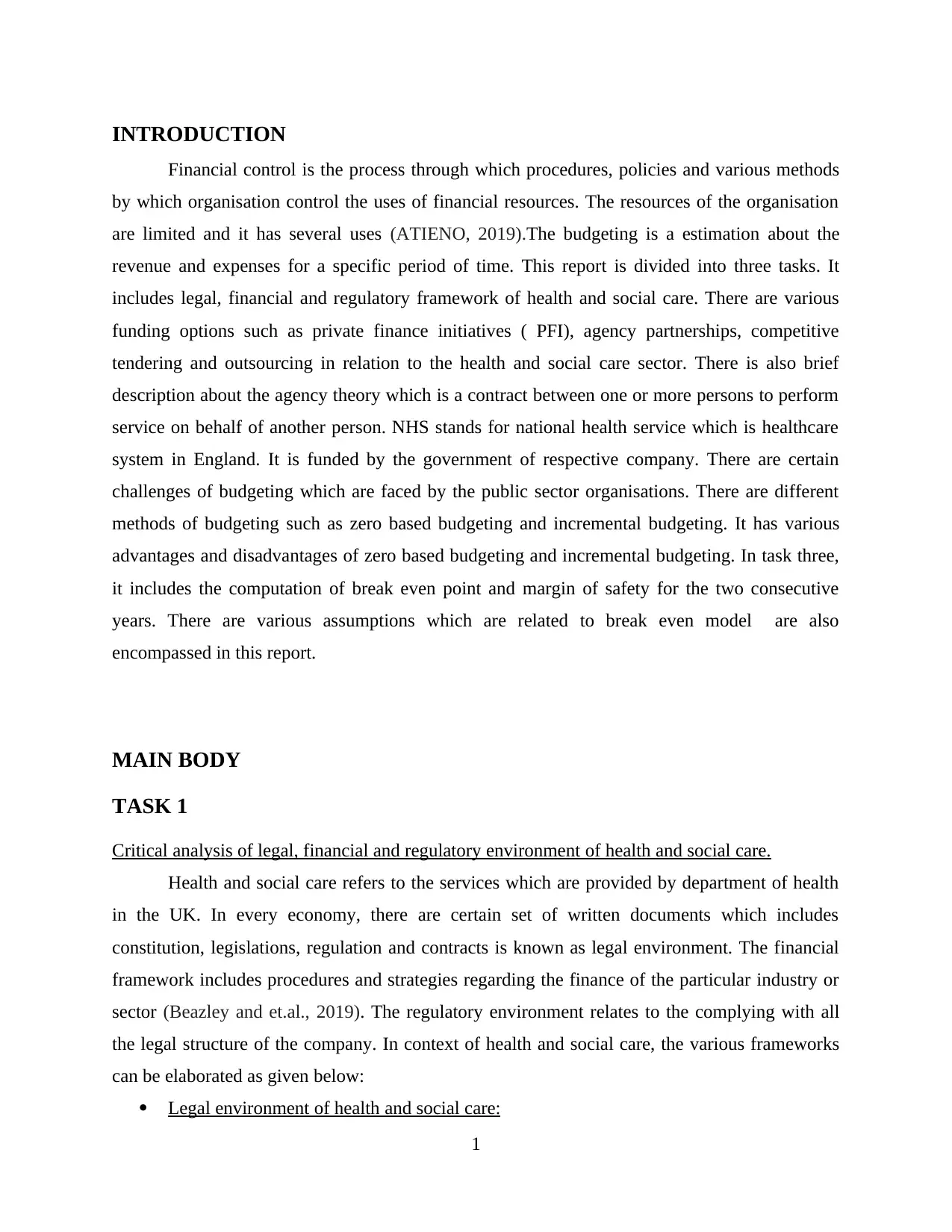
INTRODUCTION
Financial control is the process through which procedures, policies and various methods
by which organisation control the uses of financial resources. The resources of the organisation
are limited and it has several uses (ATIENO, 2019).The budgeting is a estimation about the
revenue and expenses for a specific period of time. This report is divided into three tasks. It
includes legal, financial and regulatory framework of health and social care. There are various
funding options such as private finance initiatives ( PFI), agency partnerships, competitive
tendering and outsourcing in relation to the health and social care sector. There is also brief
description about the agency theory which is a contract between one or more persons to perform
service on behalf of another person. NHS stands for national health service which is healthcare
system in England. It is funded by the government of respective company. There are certain
challenges of budgeting which are faced by the public sector organisations. There are different
methods of budgeting such as zero based budgeting and incremental budgeting. It has various
advantages and disadvantages of zero based budgeting and incremental budgeting. In task three,
it includes the computation of break even point and margin of safety for the two consecutive
years. There are various assumptions which are related to break even model are also
encompassed in this report.
MAIN BODY
TASK 1
Critical analysis of legal, financial and regulatory environment of health and social care.
Health and social care refers to the services which are provided by department of health
in the UK. In every economy, there are certain set of written documents which includes
constitution, legislations, regulation and contracts is known as legal environment. The financial
framework includes procedures and strategies regarding the finance of the particular industry or
sector (Beazley and et.al., 2019). The regulatory environment relates to the complying with all
the legal structure of the company. In context of health and social care, the various frameworks
can be elaborated as given below:
Legal environment of health and social care:
1
Financial control is the process through which procedures, policies and various methods
by which organisation control the uses of financial resources. The resources of the organisation
are limited and it has several uses (ATIENO, 2019).The budgeting is a estimation about the
revenue and expenses for a specific period of time. This report is divided into three tasks. It
includes legal, financial and regulatory framework of health and social care. There are various
funding options such as private finance initiatives ( PFI), agency partnerships, competitive
tendering and outsourcing in relation to the health and social care sector. There is also brief
description about the agency theory which is a contract between one or more persons to perform
service on behalf of another person. NHS stands for national health service which is healthcare
system in England. It is funded by the government of respective company. There are certain
challenges of budgeting which are faced by the public sector organisations. There are different
methods of budgeting such as zero based budgeting and incremental budgeting. It has various
advantages and disadvantages of zero based budgeting and incremental budgeting. In task three,
it includes the computation of break even point and margin of safety for the two consecutive
years. There are various assumptions which are related to break even model are also
encompassed in this report.
MAIN BODY
TASK 1
Critical analysis of legal, financial and regulatory environment of health and social care.
Health and social care refers to the services which are provided by department of health
in the UK. In every economy, there are certain set of written documents which includes
constitution, legislations, regulation and contracts is known as legal environment. The financial
framework includes procedures and strategies regarding the finance of the particular industry or
sector (Beazley and et.al., 2019). The regulatory environment relates to the complying with all
the legal structure of the company. In context of health and social care, the various frameworks
can be elaborated as given below:
Legal environment of health and social care:
1
⊘ This is a preview!⊘
Do you want full access?
Subscribe today to unlock all pages.

Trusted by 1+ million students worldwide
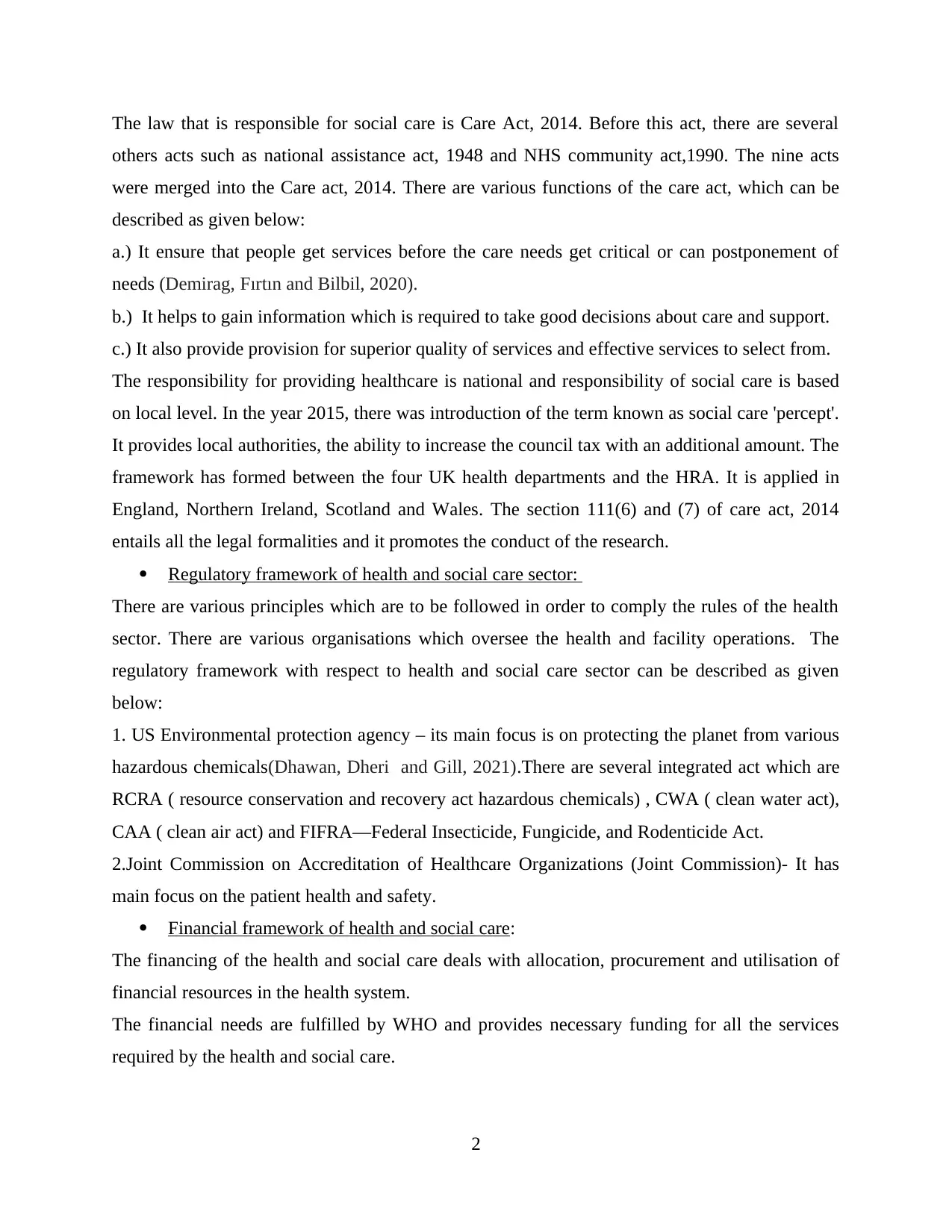
The law that is responsible for social care is Care Act, 2014. Before this act, there are several
others acts such as national assistance act, 1948 and NHS community act,1990. The nine acts
were merged into the Care act, 2014. There are various functions of the care act, which can be
described as given below:
a.) It ensure that people get services before the care needs get critical or can postponement of
needs (Demirag, Fırtın and Bilbil, 2020).
b.) It helps to gain information which is required to take good decisions about care and support.
c.) It also provide provision for superior quality of services and effective services to select from.
The responsibility for providing healthcare is national and responsibility of social care is based
on local level. In the year 2015, there was introduction of the term known as social care 'percept'.
It provides local authorities, the ability to increase the council tax with an additional amount. The
framework has formed between the four UK health departments and the HRA. It is applied in
England, Northern Ireland, Scotland and Wales. The section 111(6) and (7) of care act, 2014
entails all the legal formalities and it promotes the conduct of the research.
Regulatory framework of health and social care sector:
There are various principles which are to be followed in order to comply the rules of the health
sector. There are various organisations which oversee the health and facility operations. The
regulatory framework with respect to health and social care sector can be described as given
below:
1. US Environmental protection agency – its main focus is on protecting the planet from various
hazardous chemicals(Dhawan, Dheri and Gill, 2021).There are several integrated act which are
RCRA ( resource conservation and recovery act hazardous chemicals) , CWA ( clean water act),
CAA ( clean air act) and FIFRA—Federal Insecticide, Fungicide, and Rodenticide Act.
2.Joint Commission on Accreditation of Healthcare Organizations (Joint Commission)- It has
main focus on the patient health and safety.
Financial framework of health and social care:
The financing of the health and social care deals with allocation, procurement and utilisation of
financial resources in the health system.
The financial needs are fulfilled by WHO and provides necessary funding for all the services
required by the health and social care.
2
others acts such as national assistance act, 1948 and NHS community act,1990. The nine acts
were merged into the Care act, 2014. There are various functions of the care act, which can be
described as given below:
a.) It ensure that people get services before the care needs get critical or can postponement of
needs (Demirag, Fırtın and Bilbil, 2020).
b.) It helps to gain information which is required to take good decisions about care and support.
c.) It also provide provision for superior quality of services and effective services to select from.
The responsibility for providing healthcare is national and responsibility of social care is based
on local level. In the year 2015, there was introduction of the term known as social care 'percept'.
It provides local authorities, the ability to increase the council tax with an additional amount. The
framework has formed between the four UK health departments and the HRA. It is applied in
England, Northern Ireland, Scotland and Wales. The section 111(6) and (7) of care act, 2014
entails all the legal formalities and it promotes the conduct of the research.
Regulatory framework of health and social care sector:
There are various principles which are to be followed in order to comply the rules of the health
sector. There are various organisations which oversee the health and facility operations. The
regulatory framework with respect to health and social care sector can be described as given
below:
1. US Environmental protection agency – its main focus is on protecting the planet from various
hazardous chemicals(Dhawan, Dheri and Gill, 2021).There are several integrated act which are
RCRA ( resource conservation and recovery act hazardous chemicals) , CWA ( clean water act),
CAA ( clean air act) and FIFRA—Federal Insecticide, Fungicide, and Rodenticide Act.
2.Joint Commission on Accreditation of Healthcare Organizations (Joint Commission)- It has
main focus on the patient health and safety.
Financial framework of health and social care:
The financing of the health and social care deals with allocation, procurement and utilisation of
financial resources in the health system.
The financial needs are fulfilled by WHO and provides necessary funding for all the services
required by the health and social care.
2
Paraphrase This Document
Need a fresh take? Get an instant paraphrase of this document with our AI Paraphraser
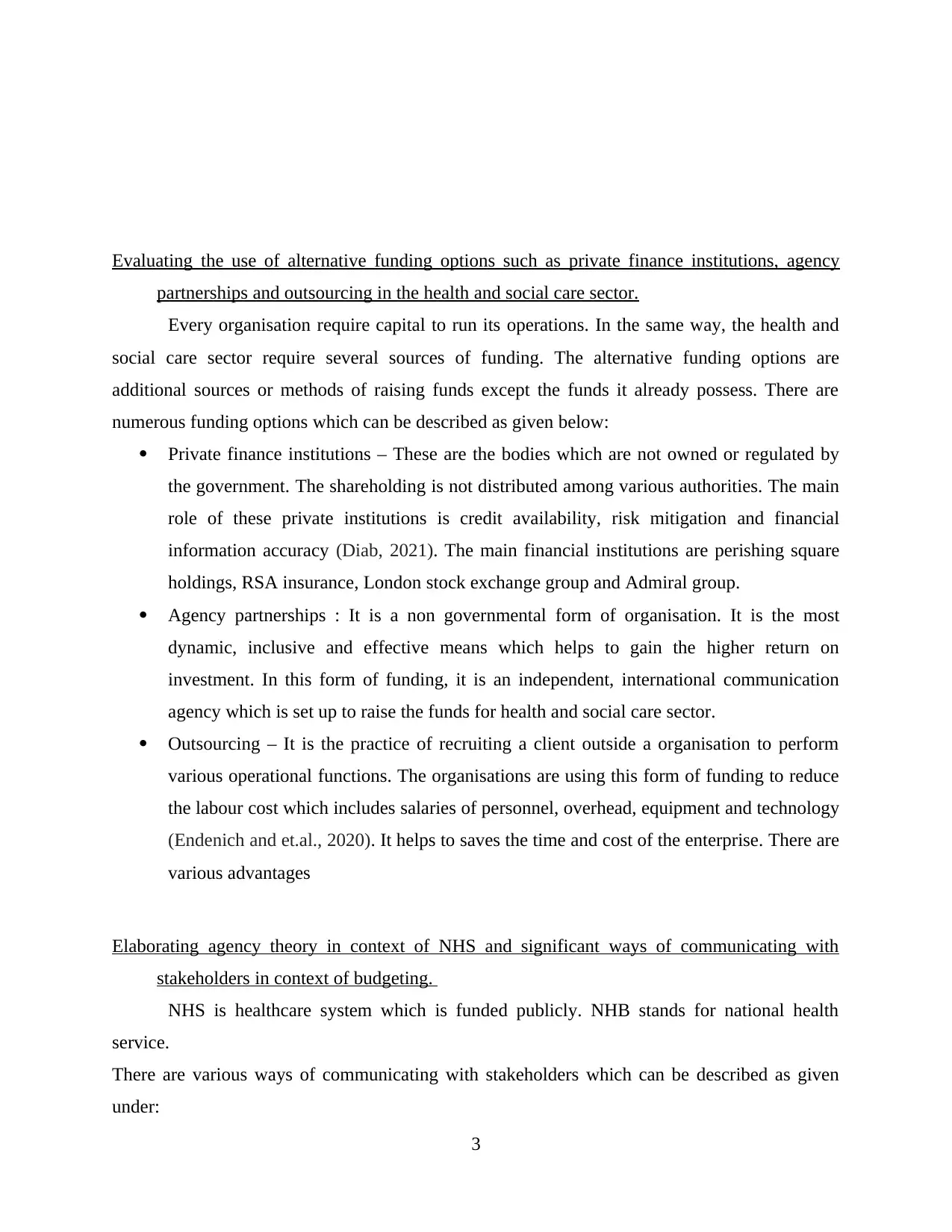
Evaluating the use of alternative funding options such as private finance institutions, agency
partnerships and outsourcing in the health and social care sector.
Every organisation require capital to run its operations. In the same way, the health and
social care sector require several sources of funding. The alternative funding options are
additional sources or methods of raising funds except the funds it already possess. There are
numerous funding options which can be described as given below:
Private finance institutions – These are the bodies which are not owned or regulated by
the government. The shareholding is not distributed among various authorities. The main
role of these private institutions is credit availability, risk mitigation and financial
information accuracy (Diab, 2021). The main financial institutions are perishing square
holdings, RSA insurance, London stock exchange group and Admiral group.
Agency partnerships : It is a non governmental form of organisation. It is the most
dynamic, inclusive and effective means which helps to gain the higher return on
investment. In this form of funding, it is an independent, international communication
agency which is set up to raise the funds for health and social care sector.
Outsourcing – It is the practice of recruiting a client outside a organisation to perform
various operational functions. The organisations are using this form of funding to reduce
the labour cost which includes salaries of personnel, overhead, equipment and technology
(Endenich and et.al., 2020). It helps to saves the time and cost of the enterprise. There are
various advantages
Elaborating agency theory in context of NHS and significant ways of communicating with
stakeholders in context of budgeting.
NHS is healthcare system which is funded publicly. NHB stands for national health
service.
There are various ways of communicating with stakeholders which can be described as given
under:
3
partnerships and outsourcing in the health and social care sector.
Every organisation require capital to run its operations. In the same way, the health and
social care sector require several sources of funding. The alternative funding options are
additional sources or methods of raising funds except the funds it already possess. There are
numerous funding options which can be described as given below:
Private finance institutions – These are the bodies which are not owned or regulated by
the government. The shareholding is not distributed among various authorities. The main
role of these private institutions is credit availability, risk mitigation and financial
information accuracy (Diab, 2021). The main financial institutions are perishing square
holdings, RSA insurance, London stock exchange group and Admiral group.
Agency partnerships : It is a non governmental form of organisation. It is the most
dynamic, inclusive and effective means which helps to gain the higher return on
investment. In this form of funding, it is an independent, international communication
agency which is set up to raise the funds for health and social care sector.
Outsourcing – It is the practice of recruiting a client outside a organisation to perform
various operational functions. The organisations are using this form of funding to reduce
the labour cost which includes salaries of personnel, overhead, equipment and technology
(Endenich and et.al., 2020). It helps to saves the time and cost of the enterprise. There are
various advantages
Elaborating agency theory in context of NHS and significant ways of communicating with
stakeholders in context of budgeting.
NHS is healthcare system which is funded publicly. NHB stands for national health
service.
There are various ways of communicating with stakeholders which can be described as given
under:
3
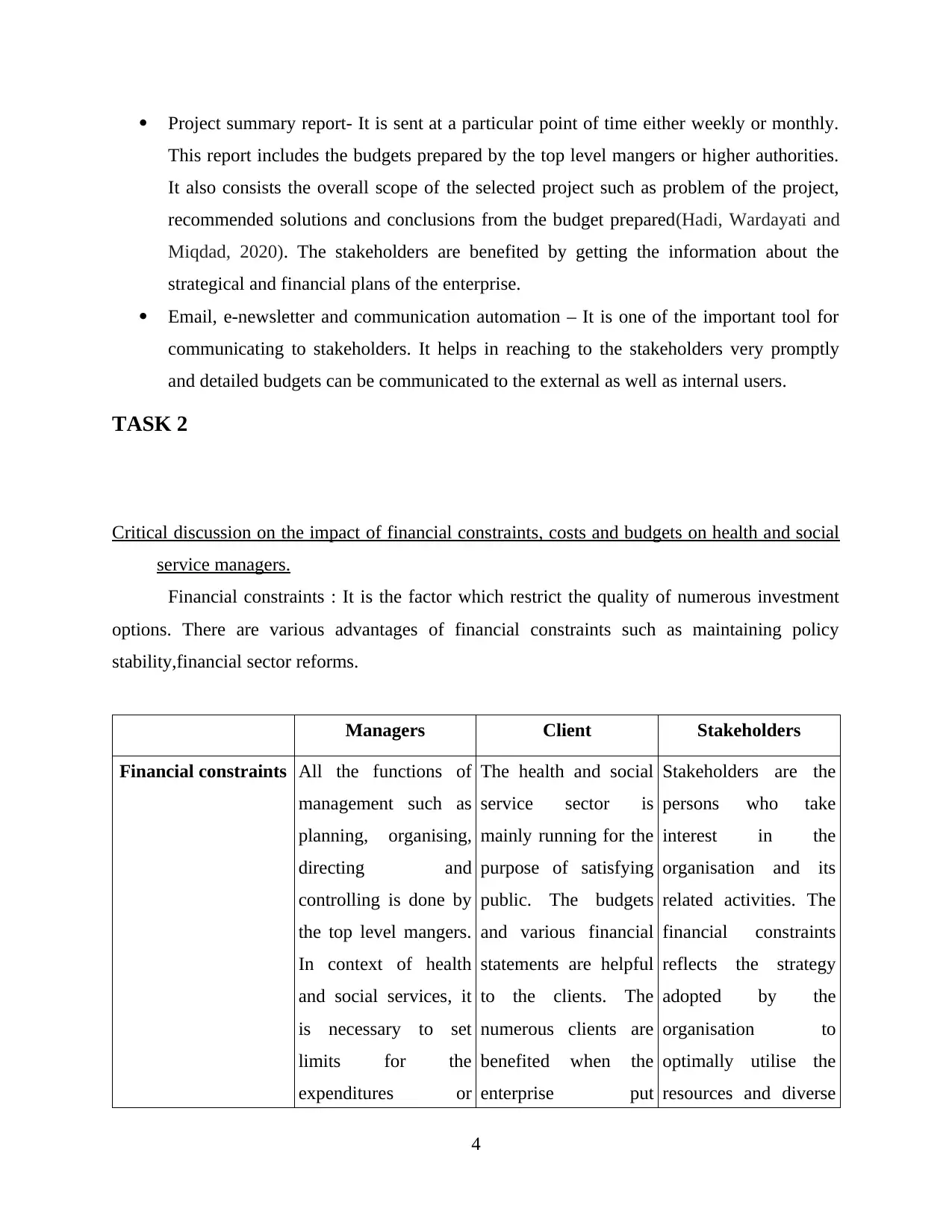
Project summary report- It is sent at a particular point of time either weekly or monthly.
This report includes the budgets prepared by the top level mangers or higher authorities.
It also consists the overall scope of the selected project such as problem of the project,
recommended solutions and conclusions from the budget prepared(Hadi, Wardayati and
Miqdad, 2020). The stakeholders are benefited by getting the information about the
strategical and financial plans of the enterprise.
Email, e-newsletter and communication automation – It is one of the important tool for
communicating to stakeholders. It helps in reaching to the stakeholders very promptly
and detailed budgets can be communicated to the external as well as internal users.
TASK 2
Critical discussion on the impact of financial constraints, costs and budgets on health and social
service managers.
Financial constraints : It is the factor which restrict the quality of numerous investment
options. There are various advantages of financial constraints such as maintaining policy
stability,financial sector reforms.
Managers Client Stakeholders
Financial constraints All the functions of
management such as
planning, organising,
directing and
controlling is done by
the top level mangers.
In context of health
and social services, it
is necessary to set
limits for the
expenditures or
The health and social
service sector is
mainly running for the
purpose of satisfying
public. The budgets
and various financial
statements are helpful
to the clients. The
numerous clients are
benefited when the
enterprise put
Stakeholders are the
persons who take
interest in the
organisation and its
related activities. The
financial constraints
reflects the strategy
adopted by the
organisation to
optimally utilise the
resources and diverse
4
This report includes the budgets prepared by the top level mangers or higher authorities.
It also consists the overall scope of the selected project such as problem of the project,
recommended solutions and conclusions from the budget prepared(Hadi, Wardayati and
Miqdad, 2020). The stakeholders are benefited by getting the information about the
strategical and financial plans of the enterprise.
Email, e-newsletter and communication automation – It is one of the important tool for
communicating to stakeholders. It helps in reaching to the stakeholders very promptly
and detailed budgets can be communicated to the external as well as internal users.
TASK 2
Critical discussion on the impact of financial constraints, costs and budgets on health and social
service managers.
Financial constraints : It is the factor which restrict the quality of numerous investment
options. There are various advantages of financial constraints such as maintaining policy
stability,financial sector reforms.
Managers Client Stakeholders
Financial constraints All the functions of
management such as
planning, organising,
directing and
controlling is done by
the top level mangers.
In context of health
and social services, it
is necessary to set
limits for the
expenditures or
The health and social
service sector is
mainly running for the
purpose of satisfying
public. The budgets
and various financial
statements are helpful
to the clients. The
numerous clients are
benefited when the
enterprise put
Stakeholders are the
persons who take
interest in the
organisation and its
related activities. The
financial constraints
reflects the strategy
adopted by the
organisation to
optimally utilise the
resources and diverse
4
⊘ This is a preview!⊘
Do you want full access?
Subscribe today to unlock all pages.

Trusted by 1+ million students worldwide
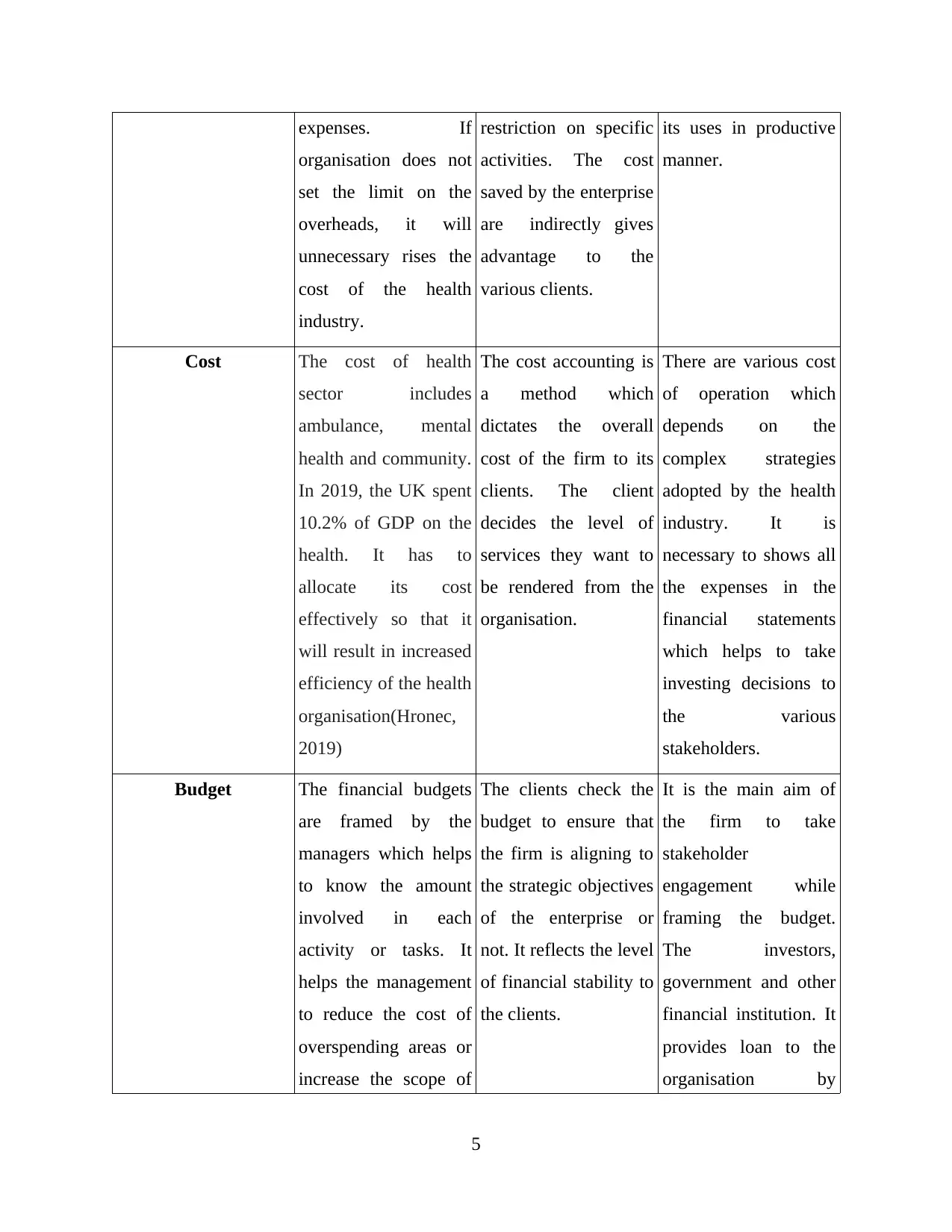
expenses. If
organisation does not
set the limit on the
overheads, it will
unnecessary rises the
cost of the health
industry.
restriction on specific
activities. The cost
saved by the enterprise
are indirectly gives
advantage to the
various clients.
its uses in productive
manner.
Cost The cost of health
sector includes
ambulance, mental
health and community.
In 2019, the UK spent
10.2% of GDP on the
health. It has to
allocate its cost
effectively so that it
will result in increased
efficiency of the health
organisation(Hronec,
2019)
The cost accounting is
a method which
dictates the overall
cost of the firm to its
clients. The client
decides the level of
services they want to
be rendered from the
organisation.
There are various cost
of operation which
depends on the
complex strategies
adopted by the health
industry. It is
necessary to shows all
the expenses in the
financial statements
which helps to take
investing decisions to
the various
stakeholders.
Budget The financial budgets
are framed by the
managers which helps
to know the amount
involved in each
activity or tasks. It
helps the management
to reduce the cost of
overspending areas or
increase the scope of
The clients check the
budget to ensure that
the firm is aligning to
the strategic objectives
of the enterprise or
not. It reflects the level
of financial stability to
the clients.
It is the main aim of
the firm to take
stakeholder
engagement while
framing the budget.
The investors,
government and other
financial institution. It
provides loan to the
organisation by
5
organisation does not
set the limit on the
overheads, it will
unnecessary rises the
cost of the health
industry.
restriction on specific
activities. The cost
saved by the enterprise
are indirectly gives
advantage to the
various clients.
its uses in productive
manner.
Cost The cost of health
sector includes
ambulance, mental
health and community.
In 2019, the UK spent
10.2% of GDP on the
health. It has to
allocate its cost
effectively so that it
will result in increased
efficiency of the health
organisation(Hronec,
2019)
The cost accounting is
a method which
dictates the overall
cost of the firm to its
clients. The client
decides the level of
services they want to
be rendered from the
organisation.
There are various cost
of operation which
depends on the
complex strategies
adopted by the health
industry. It is
necessary to shows all
the expenses in the
financial statements
which helps to take
investing decisions to
the various
stakeholders.
Budget The financial budgets
are framed by the
managers which helps
to know the amount
involved in each
activity or tasks. It
helps the management
to reduce the cost of
overspending areas or
increase the scope of
The clients check the
budget to ensure that
the firm is aligning to
the strategic objectives
of the enterprise or
not. It reflects the level
of financial stability to
the clients.
It is the main aim of
the firm to take
stakeholder
engagement while
framing the budget.
The investors,
government and other
financial institution. It
provides loan to the
organisation by
5
Paraphrase This Document
Need a fresh take? Get an instant paraphrase of this document with our AI Paraphraser
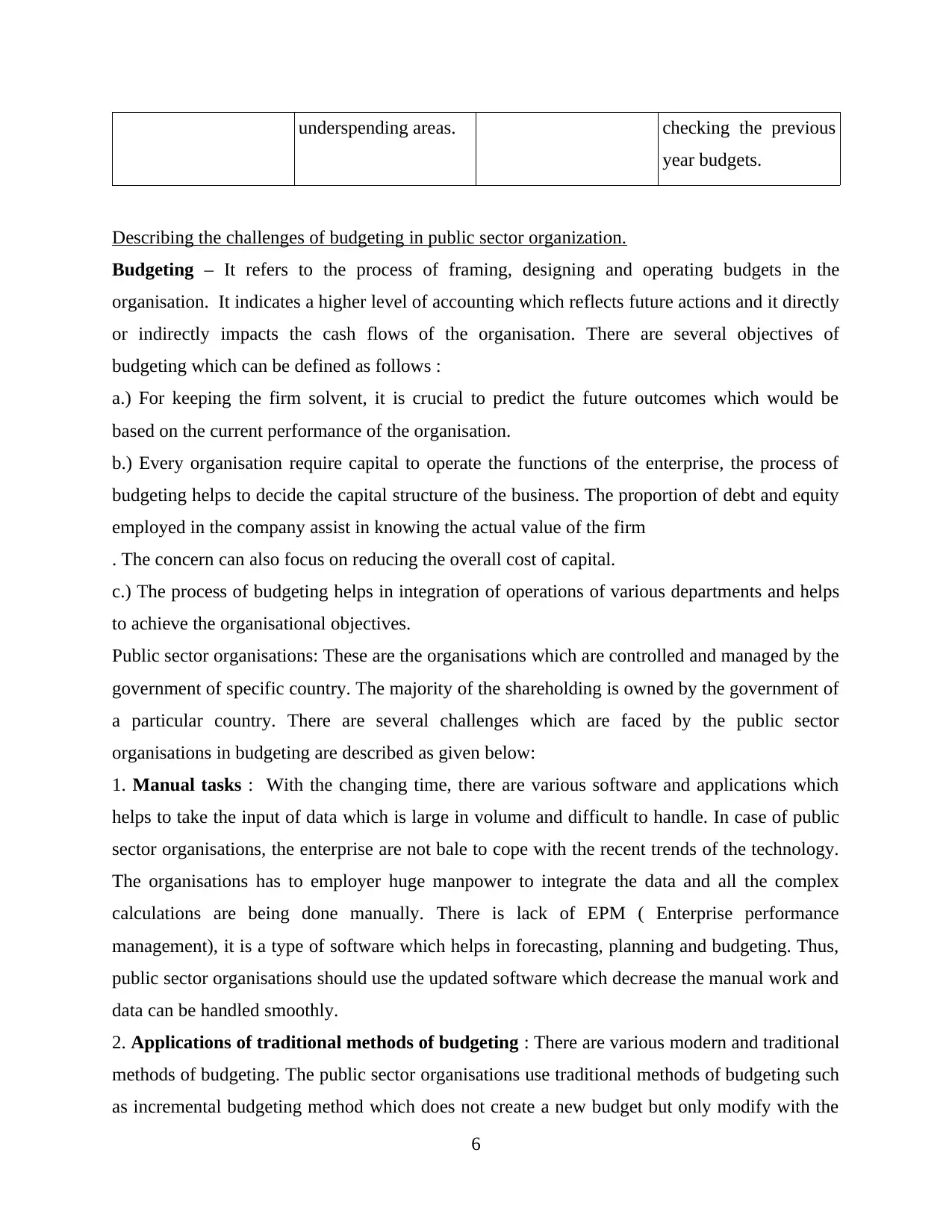
underspending areas. checking the previous
year budgets.
Describing the challenges of budgeting in public sector organization.
Budgeting – It refers to the process of framing, designing and operating budgets in the
organisation. It indicates a higher level of accounting which reflects future actions and it directly
or indirectly impacts the cash flows of the organisation. There are several objectives of
budgeting which can be defined as follows :
a.) For keeping the firm solvent, it is crucial to predict the future outcomes which would be
based on the current performance of the organisation.
b.) Every organisation require capital to operate the functions of the enterprise, the process of
budgeting helps to decide the capital structure of the business. The proportion of debt and equity
employed in the company assist in knowing the actual value of the firm
. The concern can also focus on reducing the overall cost of capital.
c.) The process of budgeting helps in integration of operations of various departments and helps
to achieve the organisational objectives.
Public sector organisations: These are the organisations which are controlled and managed by the
government of specific country. The majority of the shareholding is owned by the government of
a particular country. There are several challenges which are faced by the public sector
organisations in budgeting are described as given below:
1. Manual tasks : With the changing time, there are various software and applications which
helps to take the input of data which is large in volume and difficult to handle. In case of public
sector organisations, the enterprise are not bale to cope with the recent trends of the technology.
The organisations has to employer huge manpower to integrate the data and all the complex
calculations are being done manually. There is lack of EPM ( Enterprise performance
management), it is a type of software which helps in forecasting, planning and budgeting. Thus,
public sector organisations should use the updated software which decrease the manual work and
data can be handled smoothly.
2. Applications of traditional methods of budgeting : There are various modern and traditional
methods of budgeting. The public sector organisations use traditional methods of budgeting such
as incremental budgeting method which does not create a new budget but only modify with the
6
year budgets.
Describing the challenges of budgeting in public sector organization.
Budgeting – It refers to the process of framing, designing and operating budgets in the
organisation. It indicates a higher level of accounting which reflects future actions and it directly
or indirectly impacts the cash flows of the organisation. There are several objectives of
budgeting which can be defined as follows :
a.) For keeping the firm solvent, it is crucial to predict the future outcomes which would be
based on the current performance of the organisation.
b.) Every organisation require capital to operate the functions of the enterprise, the process of
budgeting helps to decide the capital structure of the business. The proportion of debt and equity
employed in the company assist in knowing the actual value of the firm
. The concern can also focus on reducing the overall cost of capital.
c.) The process of budgeting helps in integration of operations of various departments and helps
to achieve the organisational objectives.
Public sector organisations: These are the organisations which are controlled and managed by the
government of specific country. The majority of the shareholding is owned by the government of
a particular country. There are several challenges which are faced by the public sector
organisations in budgeting are described as given below:
1. Manual tasks : With the changing time, there are various software and applications which
helps to take the input of data which is large in volume and difficult to handle. In case of public
sector organisations, the enterprise are not bale to cope with the recent trends of the technology.
The organisations has to employer huge manpower to integrate the data and all the complex
calculations are being done manually. There is lack of EPM ( Enterprise performance
management), it is a type of software which helps in forecasting, planning and budgeting. Thus,
public sector organisations should use the updated software which decrease the manual work and
data can be handled smoothly.
2. Applications of traditional methods of budgeting : There are various modern and traditional
methods of budgeting. The public sector organisations use traditional methods of budgeting such
as incremental budgeting method which does not create a new budget but only modify with the
6
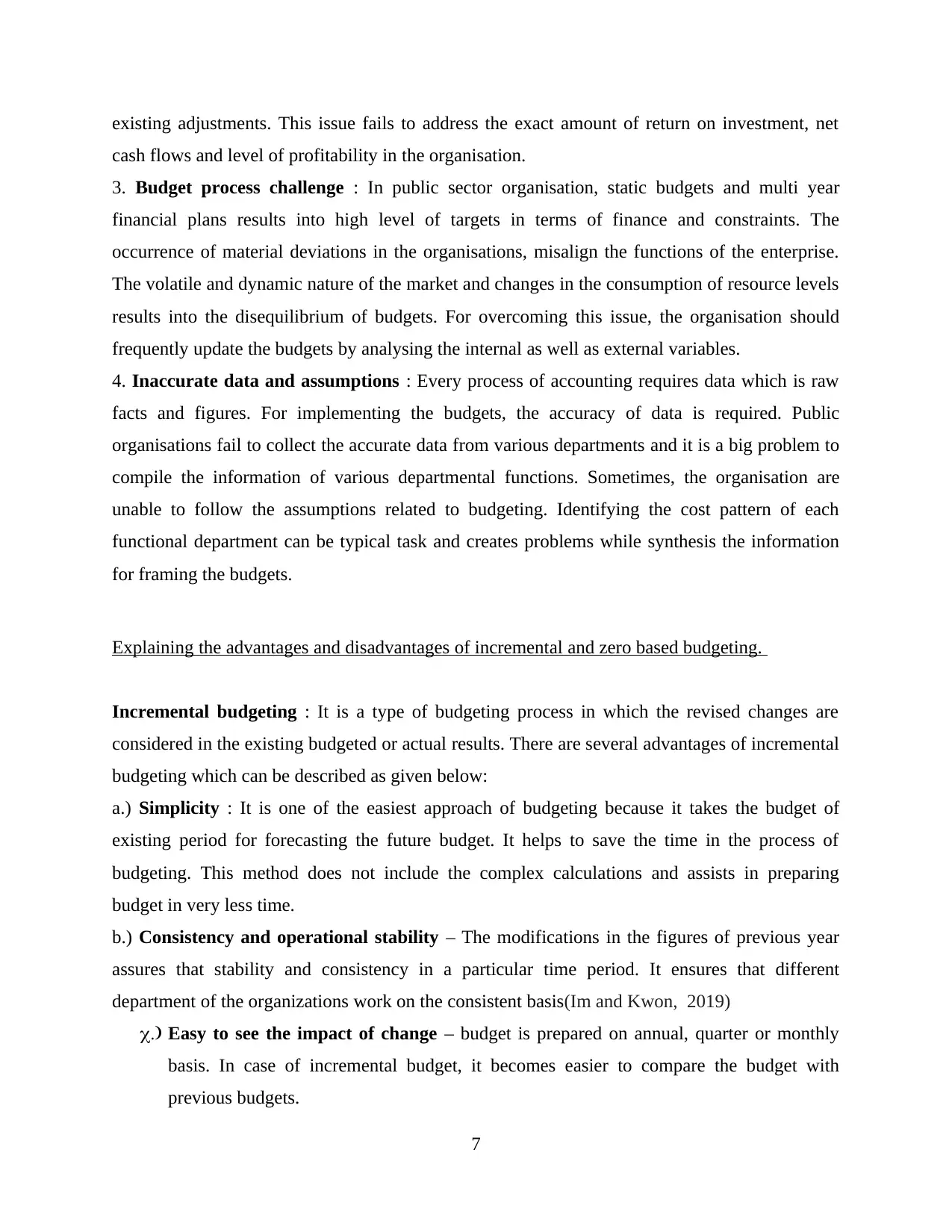
existing adjustments. This issue fails to address the exact amount of return on investment, net
cash flows and level of profitability in the organisation.
3. Budget process challenge : In public sector organisation, static budgets and multi year
financial plans results into high level of targets in terms of finance and constraints. The
occurrence of material deviations in the organisations, misalign the functions of the enterprise.
The volatile and dynamic nature of the market and changes in the consumption of resource levels
results into the disequilibrium of budgets. For overcoming this issue, the organisation should
frequently update the budgets by analysing the internal as well as external variables.
4. Inaccurate data and assumptions : Every process of accounting requires data which is raw
facts and figures. For implementing the budgets, the accuracy of data is required. Public
organisations fail to collect the accurate data from various departments and it is a big problem to
compile the information of various departmental functions. Sometimes, the organisation are
unable to follow the assumptions related to budgeting. Identifying the cost pattern of each
functional department can be typical task and creates problems while synthesis the information
for framing the budgets.
Explaining the advantages and disadvantages of incremental and zero based budgeting.
Incremental budgeting : It is a type of budgeting process in which the revised changes are
considered in the existing budgeted or actual results. There are several advantages of incremental
budgeting which can be described as given below:
a.) Simplicity : It is one of the easiest approach of budgeting because it takes the budget of
existing period for forecasting the future budget. It helps to save the time in the process of
budgeting. This method does not include the complex calculations and assists in preparing
budget in very less time.
b.) Consistency and operational stability – The modifications in the figures of previous year
assures that stability and consistency in a particular time period. It ensures that different
department of the organizations work on the consistent basis(Im and Kwon, 2019)
c.) Easy to see the impact of change – budget is prepared on annual, quarter or monthly
basis. In case of incremental budget, it becomes easier to compare the budget with
previous budgets.
7
cash flows and level of profitability in the organisation.
3. Budget process challenge : In public sector organisation, static budgets and multi year
financial plans results into high level of targets in terms of finance and constraints. The
occurrence of material deviations in the organisations, misalign the functions of the enterprise.
The volatile and dynamic nature of the market and changes in the consumption of resource levels
results into the disequilibrium of budgets. For overcoming this issue, the organisation should
frequently update the budgets by analysing the internal as well as external variables.
4. Inaccurate data and assumptions : Every process of accounting requires data which is raw
facts and figures. For implementing the budgets, the accuracy of data is required. Public
organisations fail to collect the accurate data from various departments and it is a big problem to
compile the information of various departmental functions. Sometimes, the organisation are
unable to follow the assumptions related to budgeting. Identifying the cost pattern of each
functional department can be typical task and creates problems while synthesis the information
for framing the budgets.
Explaining the advantages and disadvantages of incremental and zero based budgeting.
Incremental budgeting : It is a type of budgeting process in which the revised changes are
considered in the existing budgeted or actual results. There are several advantages of incremental
budgeting which can be described as given below:
a.) Simplicity : It is one of the easiest approach of budgeting because it takes the budget of
existing period for forecasting the future budget. It helps to save the time in the process of
budgeting. This method does not include the complex calculations and assists in preparing
budget in very less time.
b.) Consistency and operational stability – The modifications in the figures of previous year
assures that stability and consistency in a particular time period. It ensures that different
department of the organizations work on the consistent basis(Im and Kwon, 2019)
c.) Easy to see the impact of change – budget is prepared on annual, quarter or monthly
basis. In case of incremental budget, it becomes easier to compare the budget with
previous budgets.
7
⊘ This is a preview!⊘
Do you want full access?
Subscribe today to unlock all pages.

Trusted by 1+ million students worldwide
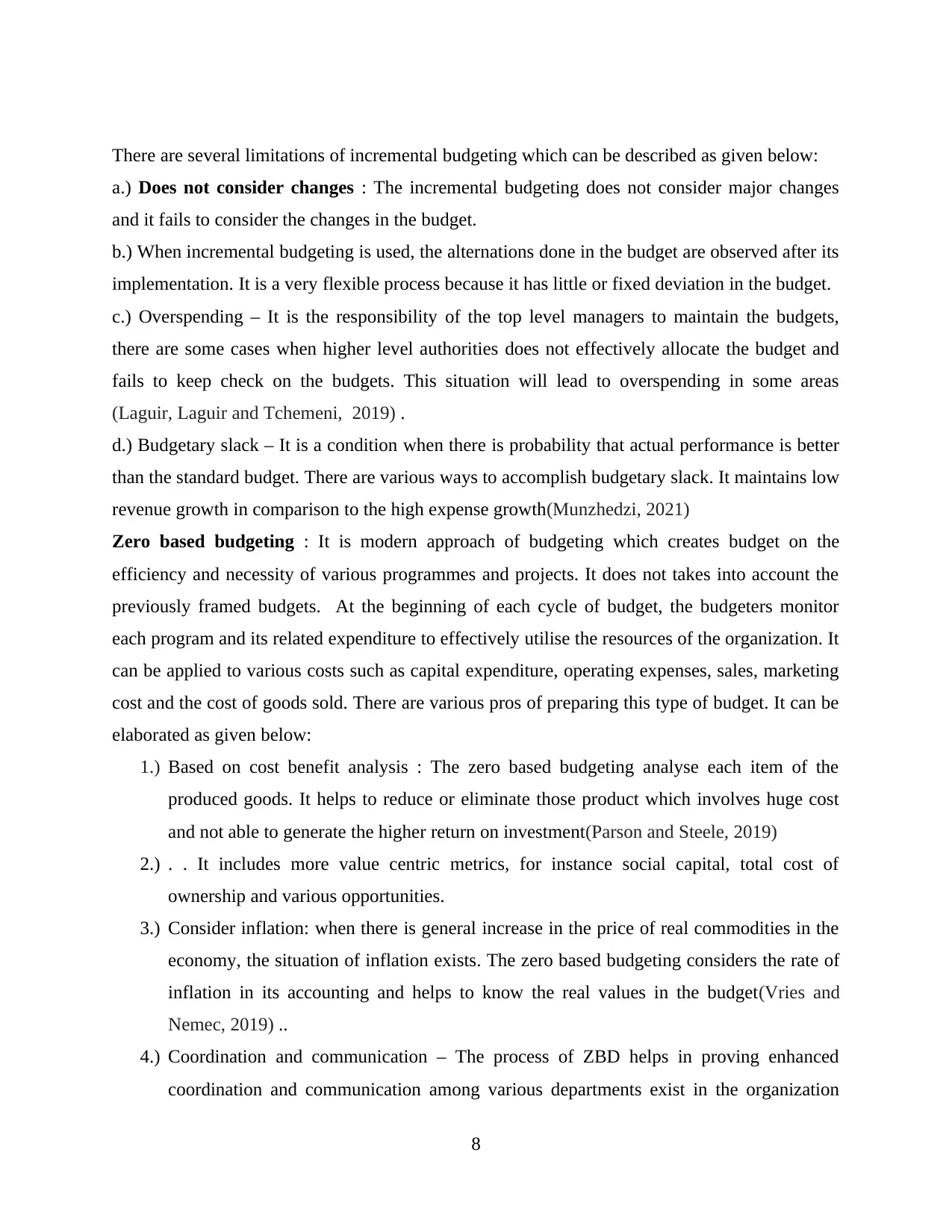
There are several limitations of incremental budgeting which can be described as given below:
a.) Does not consider changes : The incremental budgeting does not consider major changes
and it fails to consider the changes in the budget.
b.) When incremental budgeting is used, the alternations done in the budget are observed after its
implementation. It is a very flexible process because it has little or fixed deviation in the budget.
c.) Overspending – It is the responsibility of the top level managers to maintain the budgets,
there are some cases when higher level authorities does not effectively allocate the budget and
fails to keep check on the budgets. This situation will lead to overspending in some areas
(Laguir, Laguir and Tchemeni, 2019) .
d.) Budgetary slack – It is a condition when there is probability that actual performance is better
than the standard budget. There are various ways to accomplish budgetary slack. It maintains low
revenue growth in comparison to the high expense growth(Munzhedzi, 2021)
Zero based budgeting : It is modern approach of budgeting which creates budget on the
efficiency and necessity of various programmes and projects. It does not takes into account the
previously framed budgets. At the beginning of each cycle of budget, the budgeters monitor
each program and its related expenditure to effectively utilise the resources of the organization. It
can be applied to various costs such as capital expenditure, operating expenses, sales, marketing
cost and the cost of goods sold. There are various pros of preparing this type of budget. It can be
elaborated as given below:
1.) Based on cost benefit analysis : The zero based budgeting analyse each item of the
produced goods. It helps to reduce or eliminate those product which involves huge cost
and not able to generate the higher return on investment(Parson and Steele, 2019)
2.) . . It includes more value centric metrics, for instance social capital, total cost of
ownership and various opportunities.
3.) Consider inflation: when there is general increase in the price of real commodities in the
economy, the situation of inflation exists. The zero based budgeting considers the rate of
inflation in its accounting and helps to know the real values in the budget(Vries and
Nemec, 2019) ..
4.) Coordination and communication – The process of ZBD helps in proving enhanced
coordination and communication among various departments exist in the organization
8
a.) Does not consider changes : The incremental budgeting does not consider major changes
and it fails to consider the changes in the budget.
b.) When incremental budgeting is used, the alternations done in the budget are observed after its
implementation. It is a very flexible process because it has little or fixed deviation in the budget.
c.) Overspending – It is the responsibility of the top level managers to maintain the budgets,
there are some cases when higher level authorities does not effectively allocate the budget and
fails to keep check on the budgets. This situation will lead to overspending in some areas
(Laguir, Laguir and Tchemeni, 2019) .
d.) Budgetary slack – It is a condition when there is probability that actual performance is better
than the standard budget. There are various ways to accomplish budgetary slack. It maintains low
revenue growth in comparison to the high expense growth(Munzhedzi, 2021)
Zero based budgeting : It is modern approach of budgeting which creates budget on the
efficiency and necessity of various programmes and projects. It does not takes into account the
previously framed budgets. At the beginning of each cycle of budget, the budgeters monitor
each program and its related expenditure to effectively utilise the resources of the organization. It
can be applied to various costs such as capital expenditure, operating expenses, sales, marketing
cost and the cost of goods sold. There are various pros of preparing this type of budget. It can be
elaborated as given below:
1.) Based on cost benefit analysis : The zero based budgeting analyse each item of the
produced goods. It helps to reduce or eliminate those product which involves huge cost
and not able to generate the higher return on investment(Parson and Steele, 2019)
2.) . . It includes more value centric metrics, for instance social capital, total cost of
ownership and various opportunities.
3.) Consider inflation: when there is general increase in the price of real commodities in the
economy, the situation of inflation exists. The zero based budgeting considers the rate of
inflation in its accounting and helps to know the real values in the budget(Vries and
Nemec, 2019) ..
4.) Coordination and communication – The process of ZBD helps in proving enhanced
coordination and communication among various departments exist in the organization
8
Paraphrase This Document
Need a fresh take? Get an instant paraphrase of this document with our AI Paraphraser
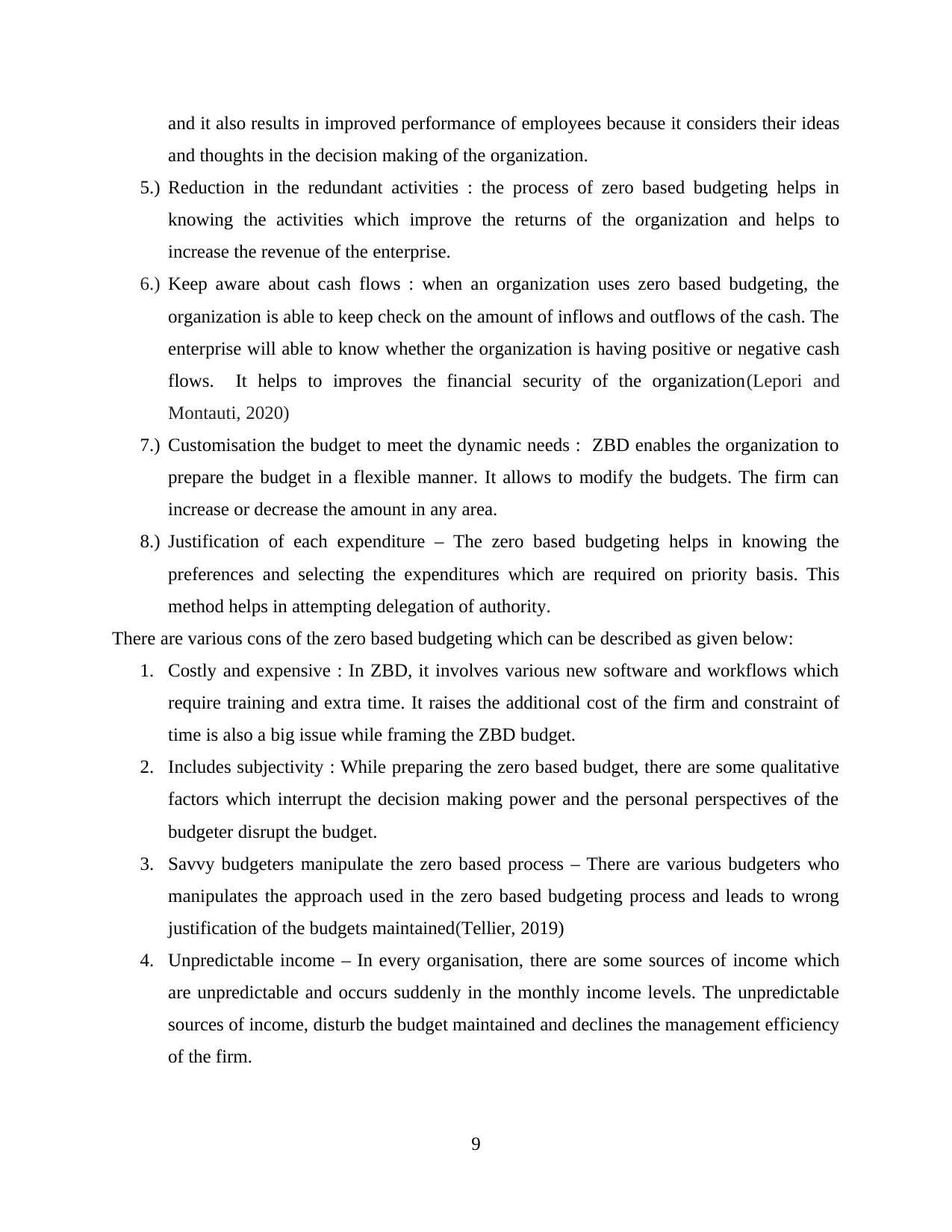
and it also results in improved performance of employees because it considers their ideas
and thoughts in the decision making of the organization.
5.) Reduction in the redundant activities : the process of zero based budgeting helps in
knowing the activities which improve the returns of the organization and helps to
increase the revenue of the enterprise.
6.) Keep aware about cash flows : when an organization uses zero based budgeting, the
organization is able to keep check on the amount of inflows and outflows of the cash. The
enterprise will able to know whether the organization is having positive or negative cash
flows. It helps to improves the financial security of the organization(Lepori and
Montauti, 2020)
7.) Customisation the budget to meet the dynamic needs : ZBD enables the organization to
prepare the budget in a flexible manner. It allows to modify the budgets. The firm can
increase or decrease the amount in any area.
8.) Justification of each expenditure – The zero based budgeting helps in knowing the
preferences and selecting the expenditures which are required on priority basis. This
method helps in attempting delegation of authority.
There are various cons of the zero based budgeting which can be described as given below:
1. Costly and expensive : In ZBD, it involves various new software and workflows which
require training and extra time. It raises the additional cost of the firm and constraint of
time is also a big issue while framing the ZBD budget.
2. Includes subjectivity : While preparing the zero based budget, there are some qualitative
factors which interrupt the decision making power and the personal perspectives of the
budgeter disrupt the budget.
3. Savvy budgeters manipulate the zero based process – There are various budgeters who
manipulates the approach used in the zero based budgeting process and leads to wrong
justification of the budgets maintained(Tellier, 2019)
4. Unpredictable income – In every organisation, there are some sources of income which
are unpredictable and occurs suddenly in the monthly income levels. The unpredictable
sources of income, disturb the budget maintained and declines the management efficiency
of the firm.
9
and thoughts in the decision making of the organization.
5.) Reduction in the redundant activities : the process of zero based budgeting helps in
knowing the activities which improve the returns of the organization and helps to
increase the revenue of the enterprise.
6.) Keep aware about cash flows : when an organization uses zero based budgeting, the
organization is able to keep check on the amount of inflows and outflows of the cash. The
enterprise will able to know whether the organization is having positive or negative cash
flows. It helps to improves the financial security of the organization(Lepori and
Montauti, 2020)
7.) Customisation the budget to meet the dynamic needs : ZBD enables the organization to
prepare the budget in a flexible manner. It allows to modify the budgets. The firm can
increase or decrease the amount in any area.
8.) Justification of each expenditure – The zero based budgeting helps in knowing the
preferences and selecting the expenditures which are required on priority basis. This
method helps in attempting delegation of authority.
There are various cons of the zero based budgeting which can be described as given below:
1. Costly and expensive : In ZBD, it involves various new software and workflows which
require training and extra time. It raises the additional cost of the firm and constraint of
time is also a big issue while framing the ZBD budget.
2. Includes subjectivity : While preparing the zero based budget, there are some qualitative
factors which interrupt the decision making power and the personal perspectives of the
budgeter disrupt the budget.
3. Savvy budgeters manipulate the zero based process – There are various budgeters who
manipulates the approach used in the zero based budgeting process and leads to wrong
justification of the budgets maintained(Tellier, 2019)
4. Unpredictable income – In every organisation, there are some sources of income which
are unpredictable and occurs suddenly in the monthly income levels. The unpredictable
sources of income, disturb the budget maintained and declines the management efficiency
of the firm.
9
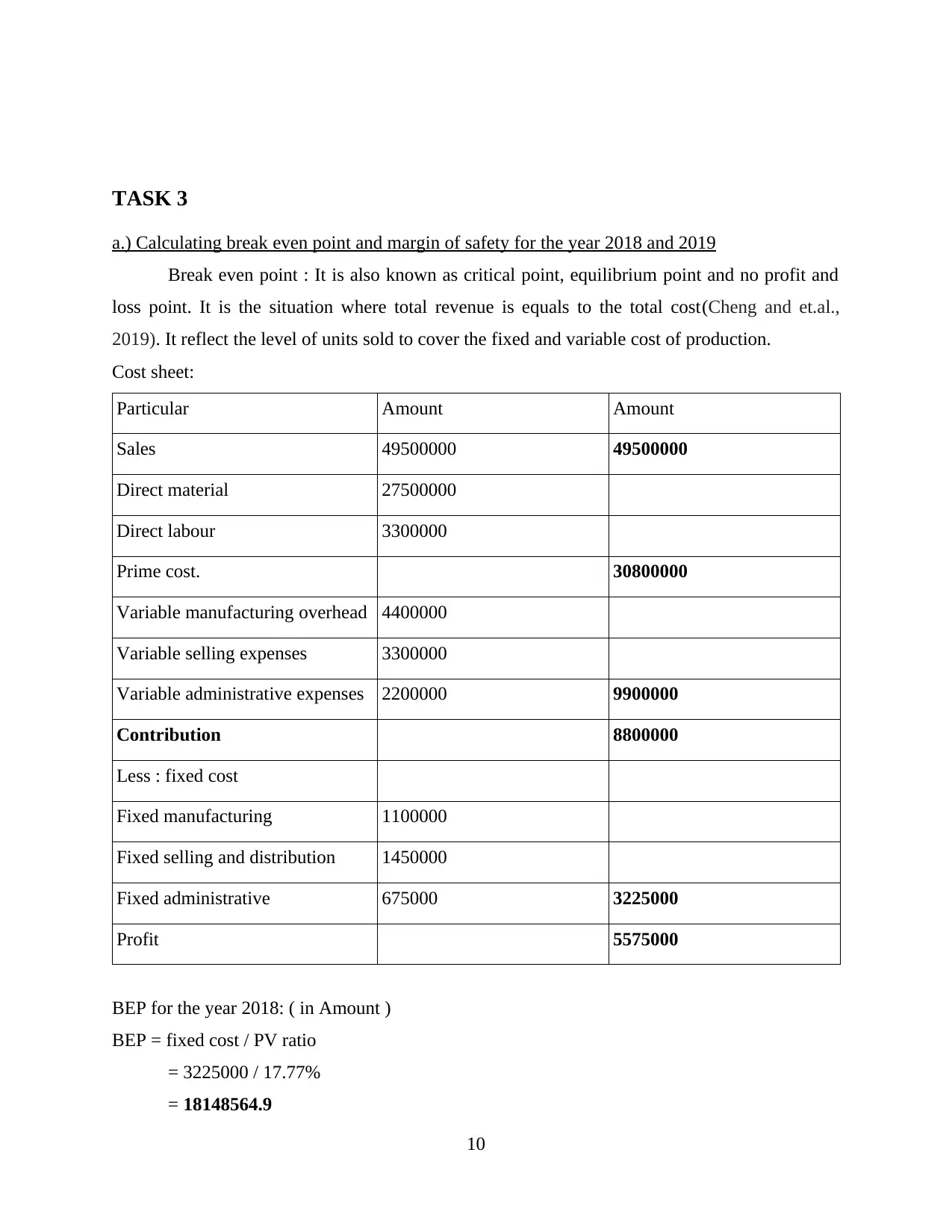
TASK 3
a.) Calculating break even point and margin of safety for the year 2018 and 2019
Break even point : It is also known as critical point, equilibrium point and no profit and
loss point. It is the situation where total revenue is equals to the total cost(Cheng and et.al.,
2019). It reflect the level of units sold to cover the fixed and variable cost of production.
Cost sheet:
Particular Amount Amount
Sales 49500000 49500000
Direct material 27500000
Direct labour 3300000
Prime cost. 30800000
Variable manufacturing overhead 4400000
Variable selling expenses 3300000
Variable administrative expenses 2200000 9900000
Contribution 8800000
Less : fixed cost
Fixed manufacturing 1100000
Fixed selling and distribution 1450000
Fixed administrative 675000 3225000
Profit 5575000
BEP for the year 2018: ( in Amount )
BEP = fixed cost / PV ratio
= 3225000 / 17.77%
= 18148564.9
10
a.) Calculating break even point and margin of safety for the year 2018 and 2019
Break even point : It is also known as critical point, equilibrium point and no profit and
loss point. It is the situation where total revenue is equals to the total cost(Cheng and et.al.,
2019). It reflect the level of units sold to cover the fixed and variable cost of production.
Cost sheet:
Particular Amount Amount
Sales 49500000 49500000
Direct material 27500000
Direct labour 3300000
Prime cost. 30800000
Variable manufacturing overhead 4400000
Variable selling expenses 3300000
Variable administrative expenses 2200000 9900000
Contribution 8800000
Less : fixed cost
Fixed manufacturing 1100000
Fixed selling and distribution 1450000
Fixed administrative 675000 3225000
Profit 5575000
BEP for the year 2018: ( in Amount )
BEP = fixed cost / PV ratio
= 3225000 / 17.77%
= 18148564.9
10
⊘ This is a preview!⊘
Do you want full access?
Subscribe today to unlock all pages.

Trusted by 1+ million students worldwide
1 out of 17
Related Documents
Your All-in-One AI-Powered Toolkit for Academic Success.
+13062052269
info@desklib.com
Available 24*7 on WhatsApp / Email
![[object Object]](/_next/static/media/star-bottom.7253800d.svg)
Unlock your academic potential
Copyright © 2020–2025 A2Z Services. All Rights Reserved. Developed and managed by ZUCOL.




